| GAWLER - SOUTH AUSTRALIA |
|
Gawler is located on the Sturt Highway (20) 45 km. east of Adelaide is the gateway
to the Barossa Valley. It is a major commercial and agricultural centre
Gawler is a pretty town, situated where the North Para River, flowing from
the Barossa Valley, meets the South Para. It is the hub of a prosperous agricultural
region, and a social, commercial and industrial centre, for a rapidly growing
population.
Named after one of Adelaide's early Governors, Gawler is considered one of South Australia's most historically important towns. Walking tours of the town have been designed to encompass the fine array of colonial architecture found in public buildings, churches and homes. A section of the original town has been declared a State Heritage Area to preserve the historic integrity of the streetscapes. Near the by-pass of the town is the Gawler Trotting Club and gliders can often be seen soaring above from their nearby base. Within the town is the picturesque Gawler Racecourse which is also the venue for the renowned Gawler Three Day Equestrian Event, held annually. Beside the river are picnic areas and a par 3 golf course. the attractive Gawler Golf Course is found along the Lyndoch Rd into the Barossa valley. The upper reaches of the South Para River, and the reservoirs of them, are suitable for fishing. Trout and Perch are replenished annually, with fingerlings from Victorian and local hatcheries. Fish up to 2kg. can be landed.
PLACES OF INTEREST: Australia's leading wine producing area Originally a Telegraph Station built in 1859 the displays include a pioneer kitchen, sitting room, sitting room, music room and a bedroom with a 4 post bed. There is also a dairy with a milking machine collection, and a grocery store. ACCOMMODATION IN GAWLER: 
|
|
GAWLER HISTORY Colonel William Light, the surveyor and planner of Adelaide, had recommended a township at the junction of the North and South Para Rivers which converge in the town. It was founded in January 1839 and is South Australia's oldest country town. John Reed and Henry Murray (among others) surveyed 4,000 acres at the site and Light supplied the plan for the city of Gawler while William Jacob laid out the street plan. It was named for the second South Australian Governor Lieutenant-Colonel George Gawler, KH, (21 July 1795 7 May 1869) who oversaw the new colony from 17 October 1838 until 15 May 1841. Its location 45km north of Adelaide and at the western entrance to the Barossa Valley makes it a popular tourist destination for those visiting the Clare and Barossa Valley wineries. It was not always so. The discovery and mining of copper at nearby Kapunda (1842), and further north at Burra (1845). opened the fledgling town to a busy trade with bullock teams passing through the town to the wharves at Port Adelaide and back. Meanwhile the fertile soils of the Adelaide Plains surrounding the town produced cereal crops with several large mills established to process the grain. In 1848 James Martin established an engineering business which provided work for 700 people manufacturing farm equipment and machinery, steel lace-work, bridges and even locomotives. A decline in rural production and the establishing of a locomotive factory at Islington by the government led to the demise of James Martin & Co in the early 20th century. By this time however, the Barossa Valley was gaining a reputation as a quality wine producing area and attracting visitors who passed through Gawler. The attractive banks of the rivers provided a popular picnic area on the way to the wineries and tourism became an important contributor to the economy. |
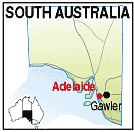
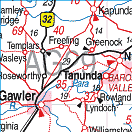
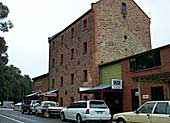
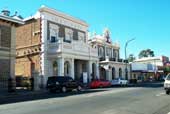
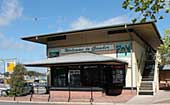


 SEE GAWLER MAP
SEE GAWLER MAP